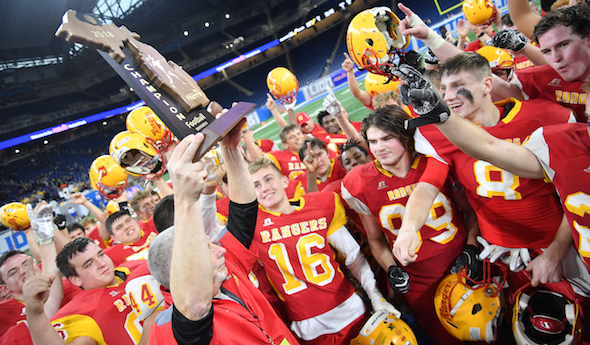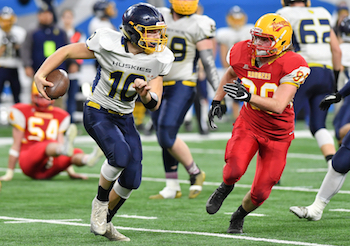
Reading is Believing for 1st-Time Champ
November 23, 2018
By Geoff Kimmerly
Second Half editor
DETROIT – Alex Price’s 11 words – or rather, 56 characters – last Nov. 25 spoke volumes.
And he and his teammates made them count during Friday morning’s Division 8 Final at Ford Field.
Two days shy of a year ago, the Reading now-senior quarterback tweeted that his team would be making the trip to Detroit this weekend. It was quite a prediction. The Rangers had just finished 8-3 – but hadn’t reached a Semifinal since 2008 and had never played in an MHSAA football championship game.
Well, Reading is believing. Breckenridge scored first Friday, but the Rangers popped back up and broke away for a 39-20 win and their first Finals championship in this sport.
The win actually capped a three-year run that saw three freshmen and seven sophomores join the varsity in 2016, boosting that team from 11 to 21 players even as the overall level of experience fell dramatically. Reading finished only 3-6 that season, but set the stage for the team to play on the state’s biggest.
“What’s special is the kids,” Reading coach Rick Bailey said. “Basically we played that (2016) year with a junior varsity team at the varsity level. We went 3-6, but we competed in every game. They decided back then they were going to make it happen.”
can’t say I wasn’t wrong... https://t.co/cQQ3uMCrTH
— alex (@alex_price2035) November 17, 2018
Friday morning was going to be filled with firsts, regardless of the winner. Breckenridge also was making its first MHSAA Finals appearance in football, and both teams were undefeated heading into the day.
Reading (13-0) rarely had been stopped this season – even the local police escorted the Rangers through a few red lights early Friday as part of an escort kicking off the morning march.
But they knew they were in for some challenges right away. First, Breckenridge stopped Reading on a fourth down play at the Rangers’ 32-yard-line just four minutes into the game. The Huskies followed up by scoring the game’s first touchdown, converting two fourth downs on the way to the end zone.
Reading had been giving up only 7.2 points per game, and Breckenridge suddenly led 6-0. Game on. But the Rangers’ defense – one of the most impressive in any division this fall – brought things back to even with a Finals first.
With just over a minute left in the first quarter, senior Caleb Miller’s 42-yard punt pinned the Huskies on their 1-yard-line. On the next play, Miller got a sack and the ball came loose, and junior Elijah Strine ended up with it in the end zone – the first fumble recovery for a touchdown in MHSAA championship game history. Senior
Ethan LoPresto’s 2-point conversion run put the Rangers ahead, to stay, just 14 seconds after one of the few times they trailed this fall.
“We were down when they scored first – we’re not use to that. We’re not used to teams scoring much on us at all,” Miller said. “That got the momentum up and really helped us out.”
Bailey said Breckenridge (12-1) had the toughest defense his team had seen this season. And the Huskies didn’t let up despite the disappointing and historic turn of events. But Reading began to grind, adding a touchdown on a drive of 5 minutes, 10 seconds, midway through the second quarter and extending the lead to 24-6 on a Price score to cap a 5:39 drive to start the third period.
 Breckenridge still didn’t go away, and that was saying a lot against a Reading defense that also had given up just a little more than 500 rushing yards total and only rushing touchdown over the first 13 weeks.
Breckenridge still didn’t go away, and that was saying a lot against a Reading defense that also had given up just a little more than 500 rushing yards total and only rushing touchdown over the first 13 weeks.
The Rangers held the Huskies to just 21 yards rushing for this game – but Breckenridge did get a touchdown on the ground and two through the air from senior quarterback Carter Staley to senior running back Hunter Collins, who also had the rushing score.
“I was just extremely proud of everyone on our team, pushing ourselves and pushing each other and not giving up on one another,” Staley said. “That’s just what got us here.”
LoPresto led the Reading offensive effort with 123 yards on 16 carries. Junior Hunter Midtgard had the most memorable play, breaking free in the fourth quarter off a block from junior Ben Affholter for a 57-yard score. Strine also ran for a touchdown.
No player had more than five tackles for the Rangers – but as a unit they had 10 for losses and three sacks.
Staley finished 14 of 19 passing for 177 yards and the two scores, and Collins caught six passes for 55 yards while junior back Lukas Ebright caught four for 55.
Breckenridge had a similar back story to Reading – the Huskies went 0-9 in 2015 when a handful of this team’s leaders were learning on the fly as freshmen. Four years later, 11 seniors are done but next season’s returnees have played up to another full season with extra games during the last three playoff runs.
“We’ve got a plan, and we stick to it,” Breckenridge coach Kris Robinson said. “It’s good athletes coming through, but we’ve also got a process. We’ve learned as a coaching staff, and I’m hoping we can move forward from here.”
PHOTOS: (Top) Reading celebrates its first MHSAA football championship Friday. (Middle) The Rangers’ Caleb Miller, right, chases Breckenridge quarterback Carter Staley.

NFHS Voice: Campaign Touts Benefits of High School Football
By
Karissa Niehoff
NFHS Executive Director
May 21, 2021
A full return to high school sports and performing arts programs – that’s the hope for this fall in schools across the country.
After a year of unprecedented challenges in keeping these programs going due to the pandemic, which included 11 states that conducted their primary football season this spring, there is great optimism as we look to a new school year.
Even in those states that were able to conduct activities last fall, attendance restrictions kept many fans out of stadiums and watching games online. However, with vaccine eligibility now at 12 years of age and older and with vaccinations continuing during the next three months, the likelihood of routines and traditions returning this fall grows stronger each day.
And there is no tradition more anticipated than the full-scale return of high school football. While there were 34 states there were fortunate enough to conduct football at some level last fall, the routines were anything but normal.
This fall, however, we anticipate a return to the energy and excitement of the 2019 season when 1,003,524 boys participated in 11-player football. That total marked a decline of only 2,489 from the previous year and was a good sign of a renewed confidence on the part of parents and student-athletes that concerns about the risk of injury were being addressed.
While boys participation in 11-player football has exceeded one million participants every year since 1999 and is overwhelmingly the most popular boys sport, there have been concerns about declines in past years.
Last fall, the NFHS and the National Football League announced a partnership to promote the growth, understanding and support for football at the high school level. The NFHS and NFL have been studying participation trends, developing educational tools and striving to restore confidence in students and parents that the sport is, in fact, more focused on risk minimization than ever before.
As a result, the springboard to the return of high school football next fall begins this week with the launch of the #ThisIsHSFootball campaign. Through this effort over the next few months, the NFHS will be reaching out to coaches, students, parents, officials, athletic directors and others with research information, participation trends and data on various risk mitigation efforts that, we believe, continues to make high school football safer than it has ever been.
As a part of this effort, the NFHS produced a video entitled “This is High School Football” designed to detail the benefits of participation in high school football.
As the video states, more so than at any other level of play, parents should feel good about their kids playing high school football.
>Here are some of the many educational and medical safeguards put in place the past 12 years to offer parents a comfort level about the safety standards that are a part of high school football.
► Concussion research and education. All NFHS high school playing rules require a student who is exhibiting signs of a concussion to be removed from the game and not allowed to return until the student has been cleared by a medical professional. Thanks to education and training on the part of students, coaches, trainers, parents and others, research data has shown positive trends in concussion rates. In a recent five-year period, concussion rates during practices dropped from 5.47 to 4.44 concussions per 10,000 athletic exposures.
► Concussion in Sport Course. This free online education course has been available through the NFHS Learning Center since 2010, and millions of individuals have taken the course for a deeper understanding about concussions.
► Concussion Laws. By 2014, every state had adopted state concussion laws that established mandatory protocols, and every state high school association has adopted policies that limit contact during preseason drills and in practices during the season.
► Football equipment. Manufacturers continue to produce higher quality equipment every year, and high school coaches are doing a much better job at teaching and coaching the rules of the game and making attempts to minimize risk of injury for players.
► Emergency Action Plans. Thanks to the NFHS Foundation, a copy of the “Anyone Can Save a Life” emergency action plan originally developed by the Minnesota State High School League was sent to all state high school associations and their high schools, and all schools have access to an AED to help save lives.
► Playing Rules. Risk minimization is a major focus of every NFHS sports rules committee. In football, helmet-to-helmet hits are not allowed.
High school football has been a significant part of schools, towns and communities across America for almost 100 years. The NFHS is committed to making the sport as safe as possible for the millions of kids who will play the sport in the years to come.
Dr. Karissa L. Niehoff is in her third year as executive director of the National Federation of State High School Associations (NFHS) in Indianapolis, Indiana. She is the first female to head the national leadership organization for high school athletics and performing arts activities and the sixth full-time executive director of the NFHS, which celebrated its 100th year of service during the 2018-19 school year. She previously was executive director of the Connecticut Association of Schools-Connecticut Interscholastic Athletic Conference for seven years.

